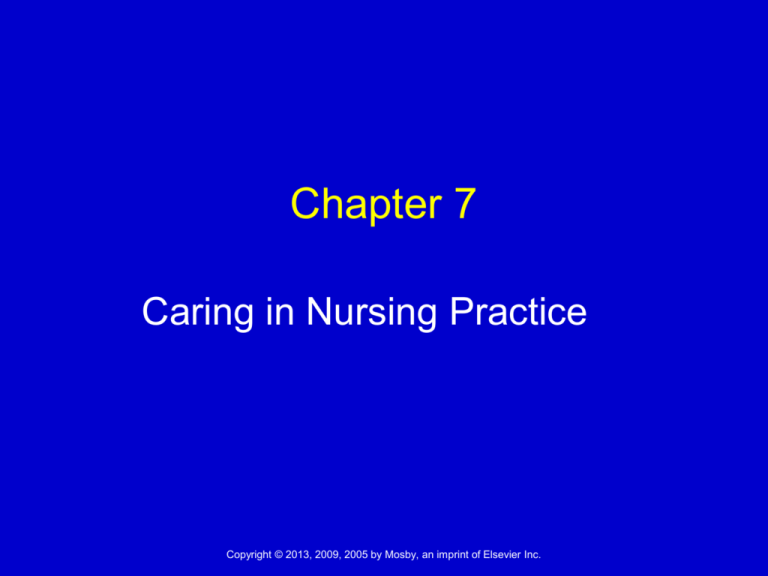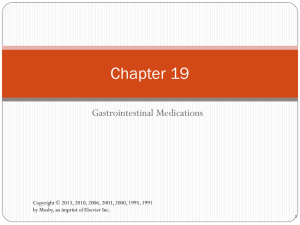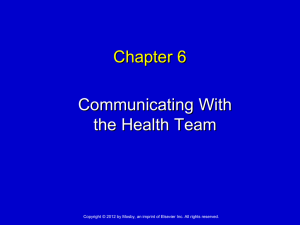Chain of Survival and EMSC
advertisement

Chapter 7 Caring in Nursing Practice Copyright © 2013, 2009, 2005 by Mosby, an imprint of Elsevier Inc. AONE Guiding Principles for Future Care Delivery Copyright © 2013, 2009, 2005 by Mosby, an imprint of Elsevier Inc. 2 Theoretical Views on Caring A universal phenomenon that influences the way we think, feel, and behave Florence Nightingale studied caring. In the 1980s, Patricia Benner and Benner with Judith Wrubel offered another definition of caring. Copyright © 2013, 2009, 2005 by Mosby, an imprint of Elsevier Inc. 3 The Essence of Nursing and Health Madeleine Leininger studied caring from a transcultural perspective. Caring is an essential human need. Caring helps an individual or group improve a human condition. Caring helps to protect, develop, nurture, and sustain people. Copyright © 2013, 2009, 2005 by Mosby, an imprint of Elsevier Inc. 4 Cultural Aspects of Care Implications for nursing practice: Know the patient’s cultural norms for caring practices. Know the patient’s cultural practices regarding end-of-life care. In some cultures, it is considered insensitive to tell the patient that he or she is dying. Copyright © 2013, 2009, 2005 by Mosby, an imprint of Elsevier Inc. 5 Cultural Aspects of Care (cont’d) Implications for nursing practice: Determine whether a member of the patient’s family or cultural group is the best resource to use for caring practices such as providing presence or touching. Know the patient’s cultural practices regarding removal of life support. Copyright © 2013, 2009, 2005 by Mosby, an imprint of Elsevier Inc. 6 Case Study Mrs. Levine is an 82-year-old patient diagnosed 2 months ago with lymphoma, a cancer of the lymph tissue. She has been experiencing weakness and fatigue. Over the past 4 weeks, she has lost 8 pounds. Mrs. Levine had been relatively independent before her diagnosis, playing bridge each week with friends and going to lunch with fellow church members. But now, she has much less energy to do the things she enjoys. Copyright © 2013, 2009, 2005 by Mosby, an imprint of Elsevier Inc. 7 Transpersonal Caring Jean Watson’s theory of caring (1988, 1979) Promotes healing and wholeness Rejects the disease orientation to health care Places care before cure Emphasizes the nurse-patient relationship Copyright © 2013, 2009, 2005 by Mosby, an imprint of Elsevier Inc. 8 Swanson’s Theory of Caring Kristen Swanson (1991) A composite of three studies in a perinatal unit Defines caring as a nurturing way of relating to a valued other, toward whom one feels a personal sense of commitment and responsibility Copyright © 2013, 2009, 2005 by Mosby, an imprint of Elsevier Inc. 9 Case Study (cont’d) Mrs. Levine’s son, Jim, lives only a few miles away and is a consistent resource when she needs transportation to the physician or trips to the grocery store. She will begin a research protocol for chemotherapy treatments this week at the oncology clinic. Copyright © 2013, 2009, 2005 by Mosby, an imprint of Elsevier Inc. 10 Patient’s Perspective of Caring Patients value the affective dimension of nursing care. Reassuring presence Recognizing an individual as unique Keeping a close and attentive eye on the situation Copyright © 2013, 2009, 2005 by Mosby, an imprint of Elsevier Inc. 11 Ethic of Care Concerned with the relationship between the patient and the nurse and the attitude of each toward the other Places the nurse as the patient’s advocate who solves ethical dilemmas by creating a relationship Gives priority to each patient as a unique being Copyright © 2013, 2009, 2005 by Mosby, an imprint of Elsevier Inc. 12 Case Study (cont’d) Sue is a nurse who has worked in the oncology clinic for over 10 years. She enters the examination room where Mrs. Levine is waiting, introduces herself, and sits down next to her patient. Sue states, “Mrs. Levine, I am here to understand your story. I want to listen and learn how I can best help you.” Sue uses eye contact while talking and leans toward Mrs. Levine to establish a physical presence. Mrs. Levine nods, smiles, and begins her story. Copyright © 2013, 2009, 2005 by Mosby, an imprint of Elsevier Inc. 13 Providing Presence Being with Eye contact Body language Tone of voice Listening Positive and encouraging attitude Copyright © 2013, 2009, 2005 by Mosby, an imprint of Elsevier Inc. 14 Caring in Nursing Practice Behaviors include being present, providing a caring touch, and listening. Caring is a product of culture, values, experiences, and relationships with others. Copyright © 2013, 2009, 2005 by Mosby, an imprint of Elsevier Inc. 15 Case Study (cont’d) Mrs. Levine explains, “I have had a good life. I just don't know what is going to happen. The doctor tells me the cancer is serious. I worry about what is going to happen to me and how it will affect my son, Jim. I do not want to become a burden to him.” Sue responds in a calm, soothing tone, “Mrs. Levine, your concerns are very normal. It is important for you to remain as independent as possible. Let’s talk about how we can do that.” Copyright © 2013, 2009, 2005 by Mosby, an imprint of Elsevier Inc. 16 Touch Provides comfort Creates a connection Contact touch Noncontact touch Protective touch Task-oriented touch Copyright © 2013, 2009, 2005 by Mosby, an imprint of Elsevier Inc. 17 Quick Quiz! 1. A female patient has just found a large lump in her breast. The physician needs to perform a breast biopsy. The nurse helps the patient into the proper position and offers support during the biopsy. The nurse is demonstrating A. Enabling. B. Comforting. C. A sense of presence. D. Maintaining belief. Copyright © 2013, 2009, 2005 by Mosby, an imprint of Elsevier Inc. 18 Case Study (cont’d) Mrs. Levine has consistently relied on her son, Jim, to provide caregiving support by assisting with transportation and being a dayto-day resource. Jim brings his mother to the outpatient oncology clinic for her first chemotherapy infusion. The total treatment will last for approximately 5 hours. Sue invites Jim to sit in the treatment area with his mother. Copyright © 2013, 2009, 2005 by Mosby, an imprint of Elsevier Inc. 19 Listening Creates trust Opens lines of communication Creates a mutual relationship Copyright © 2013, 2009, 2005 by Mosby, an imprint of Elsevier Inc. 20 Knowing the Patient Develops over time The core process of clinical decision making Aspects of knowing include: Responses to therapy, routines, and habits Coping resources Physical capacities and endurance Copyright © 2013, 2009, 2005 by Mosby, an imprint of Elsevier Inc. 21 Case Study (cont’d) Outside of the treatment room, Jim asks, “How will my mother respond to this chemotherapy? What should we be expecting?” Based on Swanson's theory of caring, what might be an appropriate response on Sue's part in “maintaining belief”? Copyright © 2013, 2009, 2005 by Mosby, an imprint of Elsevier Inc. 22 Spiritual Care Spiritual health is achieved when a person can find a balance between his life values, goals, and belief symptoms and those of others. Spirituality offers a sense of interpersonal and transpersonal connectedness. Copyright © 2013, 2009, 2005 by Mosby, an imprint of Elsevier Inc. 23 Family Care A nurse discusses a patient’s health care needs with his family. Copyright © 2013, 2009, 2005 by Mosby, an imprint of Elsevier Inc. 24 Case Study (cont’d) Three hours into the infusion, Mrs. Levine asks Sue for a glass of water and begins to talk about her pet cat and her desire to return home and be able to visit with one of her bridge partners tomorrow. Sue has another patient down the hall who has an infusion that has been under way for about an hour. What should Sue do to show her caring for Mrs. Levine? Copyright © 2013, 2009, 2005 by Mosby, an imprint of Elsevier Inc. 25 Quick Quiz! 2. When a nurse enters a patient’s room and says “Good morning” before starting care, the nurse combines nursing tasks and conversation. An important aspect of care for the nurse to remember is the need to A. Establish a relationship. B. Gather assessment data. C. Treat discomforts quickly. D. Assess the patient’s emotional needs. Copyright © 2013, 2009, 2005 by Mosby, an imprint of Elsevier Inc. 26 The Challenge of Caring TaskOriented Care Technology Improved Nurse-toPatient Ratios Copyright © 2013, 2009, 2005 by Mosby, an imprint of Elsevier Inc. 27




